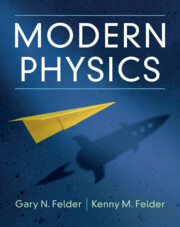Refine search
Actions for selected content:
3286 results in Quantum Physics, Quantum Information and Quantum Computation
4 - The Quantum Revolution II: Matter and Wavefunctions
-
- Book:
- Modern Physics
- Published online:
- 09 September 2022
- Print publication:
- 15 September 2022, pp 172-212
-
- Chapter
- Export citation
Contents
-
- Book:
- Quantum Mechanics
- Published online:
- 11 February 2023
- Print publication:
- 15 September 2022, pp vii-xiv
-
- Chapter
- Export citation
12 - The Atomic Nucleus
-
- Book:
- Modern Physics
- Published online:
- 09 September 2022
- Print publication:
- 15 September 2022, pp 556-595
-
- Chapter
- Export citation
Appendix G - Physical Constants
-
- Book:
- Quantum Mechanics
- Published online:
- 11 February 2023
- Print publication:
- 15 September 2022, pp 551-552
-
- Chapter
- Export citation
3 - The Quantum Revolution I: From Light Waves to Photons
-
- Book:
- Modern Physics
- Published online:
- 09 September 2022
- Print publication:
- 15 September 2022, pp 107-171
-
- Chapter
- Export citation
Appendix C - Quantum Mechanics Equations
-
- Book:
- Modern Physics
- Published online:
- 09 September 2022
- Print publication:
- 15 September 2022, pp 710-712
-
- Chapter
- Export citation

Modern Physics
-
- Published online:
- 09 September 2022
- Print publication:
- 15 September 2022
-
- Textbook
- Export citation
Figures
-
- Book:
- Quantum Information and Quantum Optics with Superconducting Circuits
- Published online:
- 04 August 2022
- Print publication:
- 18 August 2022, pp xi-xii
-
- Chapter
- Export citation
Appendix A - Hamiltonian Diagonalizations
-
- Book:
- Quantum Information and Quantum Optics with Superconducting Circuits
- Published online:
- 04 August 2022
- Print publication:
- 18 August 2022, pp 270-276
-
- Chapter
- Export citation
6 - Superconducting Qubits
-
- Book:
- Quantum Information and Quantum Optics with Superconducting Circuits
- Published online:
- 04 August 2022
- Print publication:
- 18 August 2022, pp 106-155
-
- Chapter
- Export citation
7 - Qubit–Photon Interaction
-
- Book:
- Quantum Information and Quantum Optics with Superconducting Circuits
- Published online:
- 04 August 2022
- Print publication:
- 18 August 2022, pp 156-197
-
- Chapter
- Export citation
Tables
-
- Book:
- Quantum Information and Quantum Optics with Superconducting Circuits
- Published online:
- 04 August 2022
- Print publication:
- 18 August 2022, pp xiii-xiii
-
- Chapter
- Export citation
Frontmatter
-
- Book:
- Quantum Information and Quantum Optics with Superconducting Circuits
- Published online:
- 04 August 2022
- Print publication:
- 18 August 2022, pp i-iv
-
- Chapter
- Export citation
References
-
- Book:
- Quantum Information and Quantum Optics with Superconducting Circuits
- Published online:
- 04 August 2022
- Print publication:
- 18 August 2022, pp 287-298
-
- Chapter
- Export citation
Contents
-
- Book:
- Quantum Information and Quantum Optics with Superconducting Circuits
- Published online:
- 04 August 2022
- Print publication:
- 18 August 2022, pp v-x
-
- Chapter
- Export citation
5 - Microwave Photons
-
- Book:
- Quantum Information and Quantum Optics with Superconducting Circuits
- Published online:
- 04 August 2022
- Print publication:
- 18 August 2022, pp 63-105
-
- Chapter
- Export citation
Notation
-
- Book:
- Quantum Information and Quantum Optics with Superconducting Circuits
- Published online:
- 04 August 2022
- Print publication:
- 18 August 2022, pp xiv-xiv
-
- Chapter
- Export citation
Appendix B - Open Quantum Systems
-
- Book:
- Quantum Information and Quantum Optics with Superconducting Circuits
- Published online:
- 04 August 2022
- Print publication:
- 18 August 2022, pp 277-286
-
- Chapter
- Export citation
9 - Adiabatic Quantum Computing
-
- Book:
- Quantum Information and Quantum Optics with Superconducting Circuits
- Published online:
- 04 August 2022
- Print publication:
- 18 August 2022, pp 239-269
-
- Chapter
- Export citation
8 - Quantum Computing
-
- Book:
- Quantum Information and Quantum Optics with Superconducting Circuits
- Published online:
- 04 August 2022
- Print publication:
- 18 August 2022, pp 198-238
-
- Chapter
- Export citation
